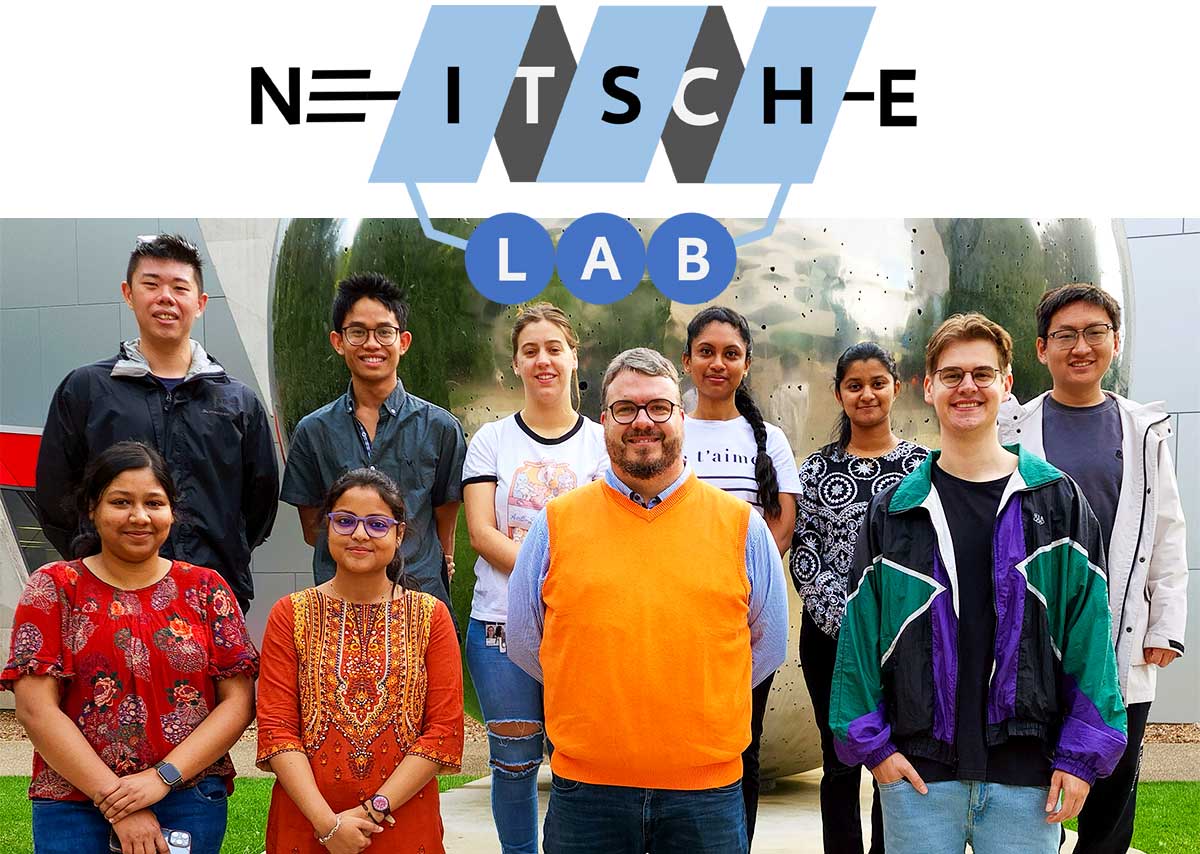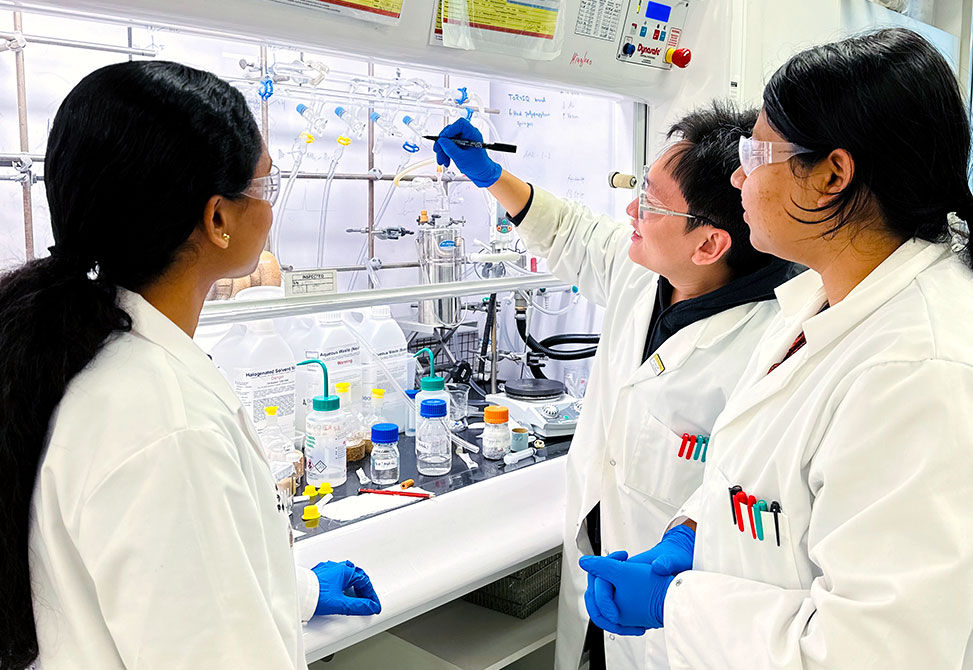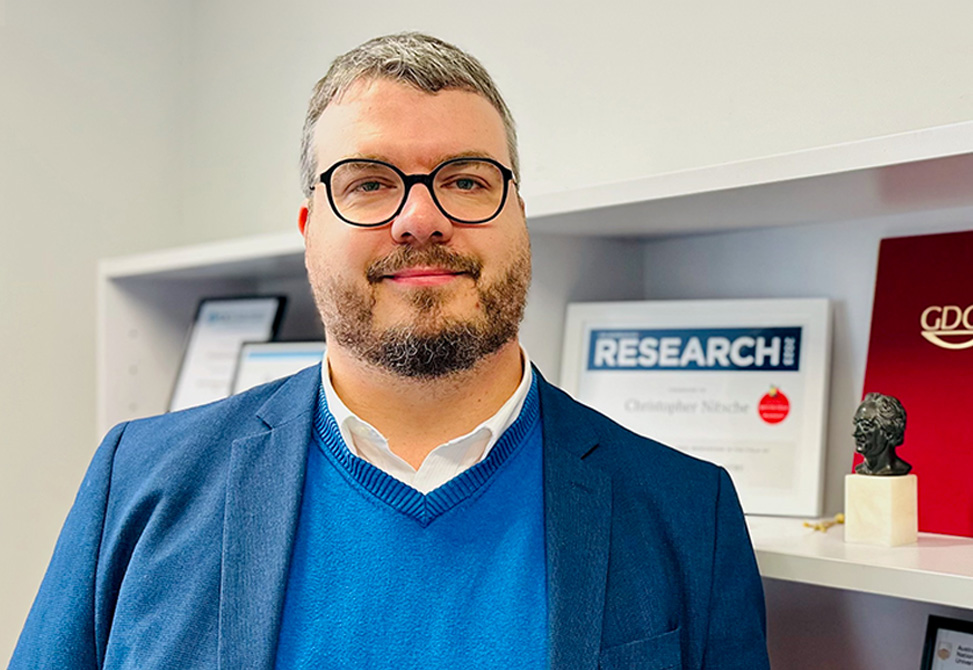Featured Lab – The Nitsche Lab
Life in the Nitsche Lab
Cutting-edge research meets a vibrant, diverse, and collaborative culture in the Nitsche lab at the Research School of Chemistry, Australian National University, Canberra. Led by Professor Christoph Nitsche, the team is dedicated to pushing the boundaries of peptide chemical biology, focusing on innovative modification techniques for constrained peptides as advanced drug leads.
A researcher’s typical day in the Nitsche lab is a blend of conducting experiments, analyzing data, and troubleshooting protocols. “Conducting the pre-planned experiments, analyzing, and documenting the resulting data are the primary tasks in my daily routine,” says Upamali, a second-year Ph.D. student in the group. “Additionally, I plan and prepare for the next day’s experiments.” she concludes.

Graduation at the Nitsche Group! From left to right: Pritha Ghosh, Lani Davies, Richard Morewood, Junming He, Sven Ullrich, Sauhta Siryer, Bishvanwesha Panda, Santhanalaxmi Kumaresan, Upamali Somathilake, Minghao Shang.
Lab members take pride in the wonderfully diverse and welcoming culture, with members from several parts of the globe. The mix of international backgrounds and perspectives brings a vast array of expertise and fresh insights, leading to a rich learning experience. Both Minghao and Santhanalaxmi, who recently joined the group as Ph.D. students, emphasize, “Our group is very diverse. Outside of work, we foster a strong sense of camaraderie and collegiality. We even organize parties and gatherings so that we can spend more time together.” Bishvanwesha, another recent addition to the group as a graduate student, adds, “Everyone in the lab is very supportive and always willing to help. You are never alone with a problem —someone in the group will always offer assistance and share their knowledge.“

Outdoor group lunch. From left to right: Richard Morewood, Pritha Ghosh, Upamali Somathilake, Santhanalaxmi Kumaresan, Minghao Shang, Sauhta Siryer, Christoph Nitsche, Bishvanwesha Panda, Lani Davies, and Sven Ullrich
Pritha, a post-doc in the group, is thankful for the supportive environment fostered by their supervisor, adding, “Christoph’s curiosity about our research drives us to explore new ideas and approaches.” Lani, who is in the final years of her Ph.D., adds, “Even when I feel mired in a research rut, Christoph always finds an interesting data point to motivate me, which really encourages me to push my limits.“
The group boasts a strong track record of maintaining frequent research collaborations across the globe. This work has been recognized by numerous awards, such as the 2022 and 2023 Australian Research Award for Best Medicinal Chemistry Lab and the 2023 Royal Australian Chemical Institute Rennie Medal. Sven, who recently graduated and was part of multiple collaborative projects, reflects, “The strong team spirit and Christoph’s excellent network were key to these recognitions. Effective teamwork relies on being proactive, maintaining open communication, and leveraging everyone’s individual abilities. This is where I feel the lab shines and never fails to impress.“
If you are interested in joining the group and contributing to groundbreaking research in peptide chemical biology, we encourage you to reach out to Pritha Ghosh, Ph.D., a postdoctoral research assistant in the lab. You can contact her via email at pritha.ghosh@anu.edu.au for more information about potential opportunities and collaborations.
We all recently celebrated a successful five-year anniversary at the Australian National University and share the feeling that the Nitsche group is on its path to many exciting discoveries in the field of peptide chemical biology.

Top row, left to right: Junming He, Sauhta Siryer, Lani Davies, Santhanalaxmi Kumaresan, Upamali Somathilake, and Minghao Shang. Bottom row, left to right: Bishvanwesha Panda, Pritha Ghosh, Christoph Nitsche, and Sven Ullrich.
What We Do
At the Nitsche Lab, we work at the intersection of chemistry and biology, specializing in peptide and protein science. We are a dynamic, interdisciplinary, and diverse research team at the Australian National University in Canberra, Australia.

At work “in the hood.” From left to right: Santhanalaxmi Kumaresan, Minghao Shang, Bishvanwesha Panda.
Our focus is on developing innovative chemical modification strategies for biomolecules to enhance their pharmaceutical properties, making them more effective as therapeutic candidates. While our lab has contributed to various areas within the field, we take particular pride in two major strategies for biocompatible peptide macrocyclization: the cyanopyridine-aminothiol conjugation and bismuth-centered peptide bicycles.

Upamali Somathilake working the discs…
Cyanopyridine-Aminothiol Reaction
The cyanopyridine-aminothiol reaction is a highly robust method that conjugates non-natural cyanopyridine functionalities with 1,2-aminothiols, which naturally occur as N-terminal cysteines. By introducing cyanopyridine into peptides as an unnatural amino acid or as a stapling reagent, we established a versatile strategy for generating constrained peptides. This breakthrough allowed us to create cyclic, stapled, and bicyclic peptides with enhanced stability and bioactivity, making them promising candidates for therapeutic applications.1-4
Peptide-Bismuth Bicycles
We have also pioneered the use of bismuth(III) as a novel reagent for constraining peptides and proteins. Bismuth, due to its thiophilic nature, binds to cysteine residues, facilitating the formation of bicyclic peptides containing three cysteines. These bismuth-centered bicyclic peptides demonstrate improved bioactivity, stability, and cell permeability. Additionally, we have extended this approach to include antimony- and arsenic-centered bicyclic peptides. By combining this methodology with phage display, we can identify targeted peptide-bismuth bicycles from genetically encoded libraries.5-8
Beyond these projects, we encourage you to visit the Nitsche Lab website for a comprehensive list of our publications and an overview of our exciting upcoming work.
Publication Information
- Nitsche, C., Onagi, H., Quek, J.-P., Otting, G., Luo, D., and Huber, T. “Biocompatible Macrocyclization between Cysteine and 2-Cyanopyridine Generates Stable Peptide Inhibitors.” Organic Letters, vol. 21, no. 12, 2019, pp. 4709–4712.
- Morewood, R., and Nitsche, C. “A Biocompatible Stapling Reaction for In Situ Generation of Constrained Peptides.” Chemical Science, vol. 12, 2021, pp. 669–674.
- Ullrich, S., George, J., Coram, A. E., Morewood, R., and Nitsche, C. “Biocompatible and Selective Generation of Bicyclic Peptides.” Angewandte Chemie International Edition, vol. 61, 2022, e202208400.
- Nitsche, C. “The Cyanopyridine–Aminothiol Click Reaction: Expanding Horizons in Chemical Biology.” Synlett, vol. 35, 2023, pp. 1067–1071.
- Voss, S., Rademann, J., and Nitsche, C. “Peptide–Bismuth Bicycles: In Situ Access to Stable Constrained Peptides with Superior Bioactivity.” Angewandte Chemie International Edition, vol. 61, 2021, e202113857.
- Voss, S., Adair, L. D., Achazi, K., Kim, H., Bergemann, S., Bartenschlager, R., New, E. J., Rademann, J., and Nitsche, C. “Cell-Penetrating Peptide-Bismuth Bicycles.” Angewandte Chemie International Edition, vol. 63, 2024, e202318615.
- Ullrich, S., Somathilake, U., Shang, M., and Nitsche, C. “Phage-Encoded Bismuth Bicycles Enable Instant Access to Targeted Bioactive Peptides.” Communications Chemistry, vol. 7, 2024, p. 143.
- Ullrich, S., Ghosh, P., Shang, M., Siryer, S., Kumaresan, S., Panda, B., Davies, L. J., Somathilake, U., Patel, A. P., and Nitsche, C. “Synthesis and Stability Studies of Constrained Peptide–Antimony Bicycles.” Australian Journal of Chemistry, 2024, vol. 77, 2024, CH24094.
A Brief Interview with Christoph Nitsche
Q: What do you enjoy most about your role as a mentor/supervisor?
A: What I enjoy most is witnessing the transformation of my students as they grow into independent, confident scientists. Watching their initial curiosity evolve into meaningful research contributions is deeply fulfilling. There’s something incredibly rewarding about seeing their hard work and determination culminate in tangible discoveries that advance our field. It’s an honor to be part of their journey as they develop their skills and leave their mark on science.
Q: What strategies do you use to ensure your students remain motivated and productive?
A: Maintaining motivation and productivity in the lab hinges on creating a supportive, collaborative environment. I believe in fostering open communication, where students feel comfortable sharing their challenges and progress. I set clear, achievable goals and provide regular feedback, ensuring that students know they are on the right track. Celebrating even the small wins is essential because it reinforces the progress being made, which helps sustain motivation. I also emphasize the importance of finding balance — allowing for creativity and flexibility while still keeping an eye on the overall objective.
Q: How do you balance providing guidance while encouraging independence in your students?
A: Striking the right balance between guidance and independence is key to fostering growth. I make it a point to be available when my students need support, whether they require advice on experimental design or feedback on data interpretation. At the same time, I encourage them to take ownership of their projects. Allowing them to make critical decisions not only builds their confidence but also enhances their problem-solving abilities. I believe that this autonomy prepares them to become leaders in their own right while knowing they can rely on me for guidance when necessary.
Q: Given there are students in the group from different parts of the world, what steps do you take to ensure all team members feel valued and included?
A: Our lab is indeed fortunate to be a microcosm of global diversity, with members from various cultural backgrounds. I see this as one of our greatest strengths. To ensure everyone feels valued, I actively promote inclusivity by encouraging team members to share their unique perspectives and experiences, both in and outside of scientific discussions. We regularly organize team-building activities, where informal interactions help strengthen the bonds between members. I strive to maintain an environment that is fair, respectful, and open to dialogue, so that everyone feels they are an integral part of the team, contributing to both the science and the culture of the lab.
Q: What are your goals/vision for your research group in the next 5 years?
A: Over the next five years, I envision our research group continuing to push the boundaries of peptide and protein modifications, particularly focusing on biocompatible techniques that harness the full potential of the periodic table. Our curiosity will remain at the forefront, driving us to explore uncharted territories and think outside the box. We also aim to strengthen our existing collaborations and form new ones that will open up exciting avenues for interdisciplinary work. Moreover, I see significant potential for commercializing some of our findings, so translating our research into real-world applications will be a priority as we move forward. Ultimately, my goal is for the group to remain dynamic and innovative, constantly contributing new knowledge to the scientific community.

Christoph Nitsche

